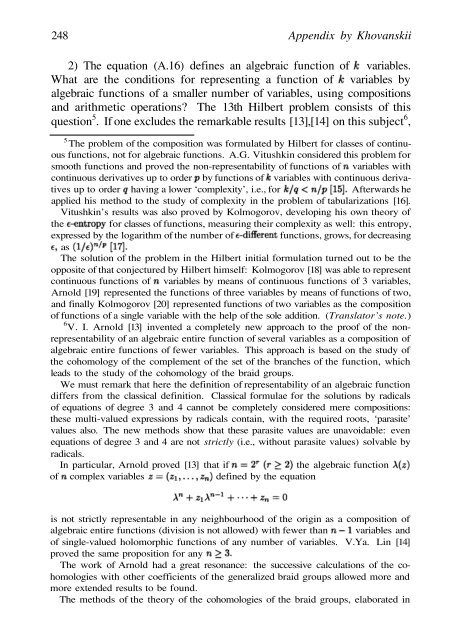Abel's theorem in problems and solutions - School of Mathematics
Abel's theorem in problems and solutions - School of Mathematics
Abel's theorem in problems and solutions - School of Mathematics
You also want an ePaper? Increase the reach of your titles
YUMPU automatically turns print PDFs into web optimized ePapers that Google loves.
248 Appendix by Khovanskii<br />
2) The equation (A.16) def<strong>in</strong>es an algebraic function <strong>of</strong> variables.<br />
What are the conditions for represent<strong>in</strong>g a function <strong>of</strong> variables by<br />
algebraic functions <strong>of</strong> a smaller number <strong>of</strong> variables, us<strong>in</strong>g compositions<br />
<strong>and</strong> arithmetic operations? The 13th Hilbert problem consists <strong>of</strong> this<br />
question 5 . If one excludes the remarkable results [13],[14] on this subject 6 ,<br />
5 The problem <strong>of</strong> the composition was formulated by Hilbert for classes <strong>of</strong> cont<strong>in</strong>uous<br />
functions, not for algebraic functions. A.G. Vitushk<strong>in</strong> considered this problem for<br />
smooth functions <strong>and</strong> proved the non-representability <strong>of</strong> functions <strong>of</strong> variables with<br />
cont<strong>in</strong>uous derivatives up to order by functions <strong>of</strong> variables with cont<strong>in</strong>uous derivatives<br />
up to order hav<strong>in</strong>g a lower ‘complexity’, i.e., for Afterwards he<br />
applied his method to the study <strong>of</strong> complexity <strong>in</strong> the problem <strong>of</strong> tabularizations [16].<br />
Vitushk<strong>in</strong>’s results was also proved by Kolmogorov, develop<strong>in</strong>g his own theory <strong>of</strong><br />
the for classes <strong>of</strong> functions, measur<strong>in</strong>g their complexity as well: this entropy,<br />
expressed by the logarithm <strong>of</strong> the number <strong>of</strong> functions, grows, for decreas<strong>in</strong>g<br />
as<br />
The solution <strong>of</strong> the problem <strong>in</strong> the Hilbert <strong>in</strong>itial formulation turned out to be the<br />
opposite <strong>of</strong> that conjectured by Hilbert himself: Kolmogorov [18] was able to represent<br />
cont<strong>in</strong>uous functions <strong>of</strong> variables by means <strong>of</strong> cont<strong>in</strong>uous functions <strong>of</strong> 3 variables,<br />
Arnold [19] represented the functions <strong>of</strong> three variables by means <strong>of</strong> functions <strong>of</strong> two,<br />
<strong>and</strong> f<strong>in</strong>ally Kolmogorov [20] represented functions <strong>of</strong> two variables as the composition<br />
<strong>of</strong> functions <strong>of</strong> a s<strong>in</strong>gle variable with the help <strong>of</strong> the sole addition. (Translator’s note.)<br />
6 V. I. Arnold [13] <strong>in</strong>vented a completely new approach to the pro<strong>of</strong> <strong>of</strong> the nonrepresentability<br />
<strong>of</strong> an algebraic entire function <strong>of</strong> several variables as a composition <strong>of</strong><br />
algebraic entire functions <strong>of</strong> fewer variables. This approach is based on the study <strong>of</strong><br />
the cohomology <strong>of</strong> the complement <strong>of</strong> the set <strong>of</strong> the branches <strong>of</strong> the function, which<br />
leads to the study <strong>of</strong> the cohomology <strong>of</strong> the braid groups.<br />
We must remark that here the def<strong>in</strong>ition <strong>of</strong> representability <strong>of</strong> an algebraic function<br />
differs from the classical def<strong>in</strong>ition. Classical formulae for the <strong>solutions</strong> by radicals<br />
<strong>of</strong> equations <strong>of</strong> degree 3 <strong>and</strong> 4 cannot be completely considered mere compositions:<br />
these multi-valued expressions by radicals conta<strong>in</strong>, with the required roots, ‘parasite’<br />
values also. The new methods show that these parasite values are unavoidable: even<br />
equations <strong>of</strong> degree 3 <strong>and</strong> 4 are not strictly (i.e., without parasite values) solvable by<br />
radicals.<br />
In particular, Arnold proved [13] that if the algebraic function<br />
<strong>of</strong> complex variables def<strong>in</strong>ed by the equation<br />
is not strictly representable <strong>in</strong> any neighbourhood <strong>of</strong> the orig<strong>in</strong> as a composition <strong>of</strong><br />
algebraic entire functions (division is not allowed) with fewer than variables <strong>and</strong><br />
<strong>of</strong> s<strong>in</strong>gle-valued holomorphic functions <strong>of</strong> any number <strong>of</strong> variables. V.Ya. L<strong>in</strong> [14]<br />
proved the same proposition for any<br />
The work <strong>of</strong> Arnold had a great resonance: the successive calculations <strong>of</strong> the cohomologies<br />
with other coefficients <strong>of</strong> the generalized braid groups allowed more <strong>and</strong><br />
more extended results to be found.<br />
The methods <strong>of</strong> the theory <strong>of</strong> the cohomologies <strong>of</strong> the braid groups, elaborated <strong>in</strong>

















